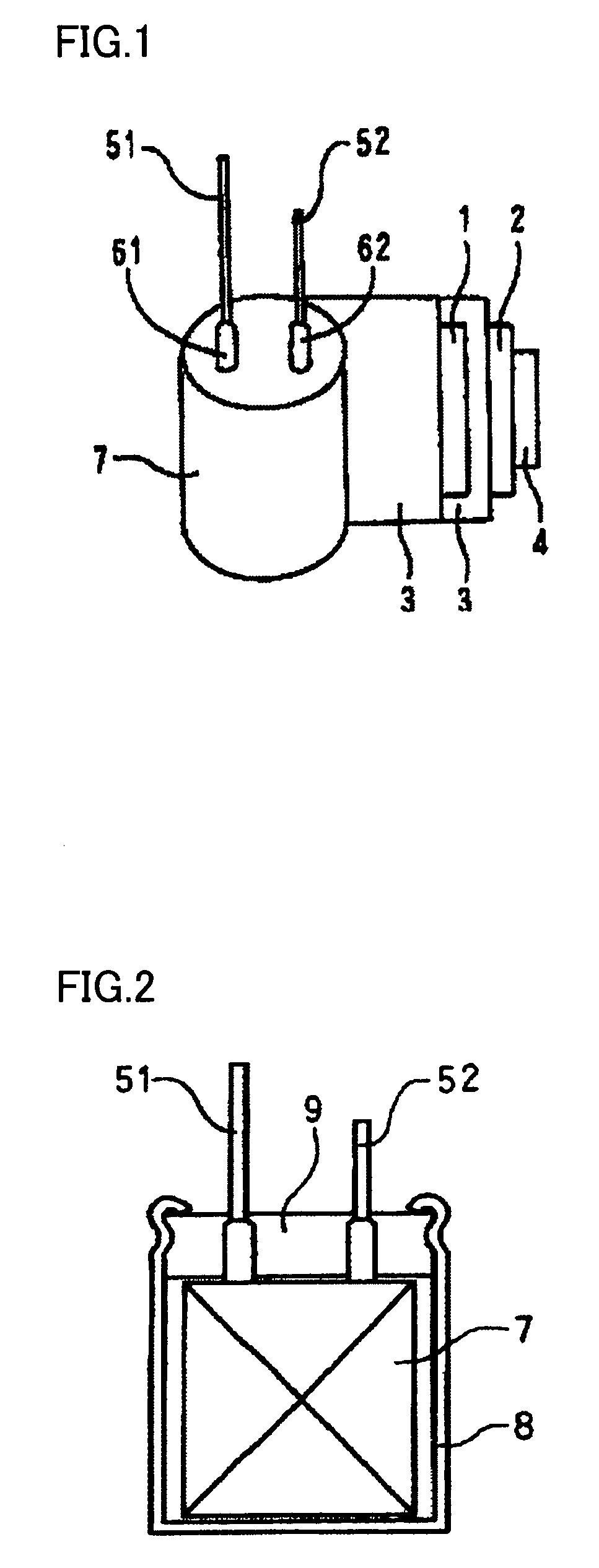Method of manufacturing electrolytic capacitor and electrolytic capacitor
a manufacturing method and electrolytic capacitor technology, applied in wound capacitors, fixed capacitors, capacitor dielectric layers, etc., can solve the problems of large operation complexity, considerable complexity in the cathode draw-out method, and relatively small capacitance of capacitors, etc., to achieve excellent voltage proofing properties, reduce leakage current, and facilitate manufacturing
- Summary
- Abstract
- Description
- Claims
- Application Information
AI Technical Summary
Benefits of technology
Problems solved by technology
Method used
Image
Examples
example 1
[0049]An aluminum capacitor element of the wound type for which the forming voltage (V) used for forming a dielectric coating film was the one as shown in Table 1, which had the dimension in the completed state (the outer dimension of an electrolytic capacitor in the state of being housed in an aluminum casing) of diameter 6.3 mm×height 6.0 mm, and which had a rated voltage of 10 V and a nominal capacitance of 100 μF was immersed in a dispersion containing polyethylenedioxythiophene and water as a solvent (polyethylenedioxythiophene concentration: 8 wt %) at 25° C. for 10 minutes under a high vacuum of 89 kPa so as to attach the dispersion to the dielectric coating film (dispersion impregnation step). While the immersion was performed, a sonicating process was performed. Then, the capacitor element was placed in a dry oven at 125° C. and kept therein for 30 minutes to evaporate the water and thereby form an electrically conductive solid layer (dry step). The dispersion impregnation ...
examples 2-12
[0053]Electrolytic capacitors were each formed by a method similar to that of Example 1 except that the rated voltage and the nominal capacitance, the dimension in the completed state (diameter in mm×height in mm), the forming voltage (V), the electrically conductive polymer and the organic salt contained in the electrolytic solution are those as shown in Table 1. The concentration (wt %) of the electrically conductive polymer in the dispersion and the concentration (wt %) of the organic salt in the electrolytic solution are identical to those of Example 1. For these electrolytic capacitors, the capacitance, ESR, tan δ (loss-angle tangent) and leakage current (LC) were measured. The results as shown in Table 1. Organic salts A, B, C, D shown in Table 1 are respectively triethylamine borodisalicylate, ethyldimethylamine phthalate, mono 1,2,3,4-tetramethylimidazolinium phthalate, mono 1,3-dimethyl-2-ethylimidazolinium phthalate.
example 13
[0059]Measurement of Solid Capacitance Realization Ratio and Confirmation of Effects of Electrolytic Solution:
[0060]Two aluminum capacitor elements of the wound type which had the dimension in the completed state (the outer dimension of an electrolytic capacitor in the state of being housed in an aluminum casing) as shown in Table 2 were each immersed in a dispersion containing polyethylenedioxythiophene and water as a solvent (polyethylenedioxythiophene concentration: 8 wt %) at 30° C. for 10 minutes under a high vacuum of 89 kPa so as to attach the dispersion to the dielectric coating film (dispersion impregnation step). While the immersion was performed, a sonicating process was performed. Then, the capacitor element was placed in a dry oven at 125° C. and kept therein for 30 minutes to evaporate the water and thereby form an electrically conductive solid layer (dry step). The dispersion impregnation step and the dry step were repeated three times in total. Subsequently, one of t...
PUM
| Property | Measurement | Unit |
|---|---|---|
| pressure | aaaaa | aaaaa |
| pressure | aaaaa | aaaaa |
| temperature | aaaaa | aaaaa |
Abstract
Description
Claims
Application Information
 Login to View More
Login to View More - R&D
- Intellectual Property
- Life Sciences
- Materials
- Tech Scout
- Unparalleled Data Quality
- Higher Quality Content
- 60% Fewer Hallucinations
Browse by: Latest US Patents, China's latest patents, Technical Efficacy Thesaurus, Application Domain, Technology Topic, Popular Technical Reports.
© 2025 PatSnap. All rights reserved.Legal|Privacy policy|Modern Slavery Act Transparency Statement|Sitemap|About US| Contact US: help@patsnap.com


